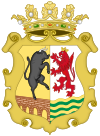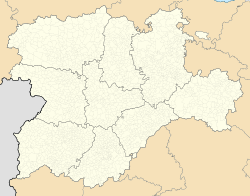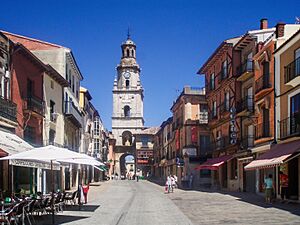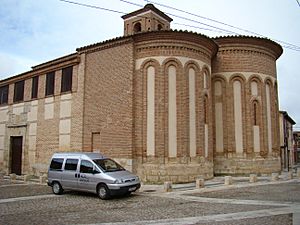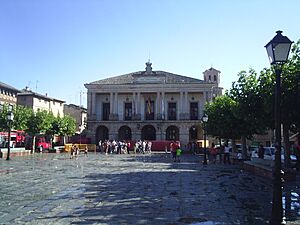Toro, Zamora facts for kids
Quick facts for kids
Toro
|
||
|---|---|---|
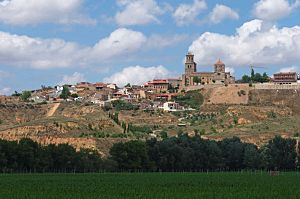
|
||
|
||
| Country | ||
| Autonomous community | ||
| Province | ||
| Comarca | Alfoz de Toro | |
| Judicial district | Toro | |
| Area | ||
| • Total | 326 km2 (126 sq mi) | |
| Elevation | 740 m (2,430 ft) | |
| Population
(2018)
|
||
| • Total | 8,789 | |
| • Density | 26.96/km2 (69.83/sq mi) | |
| Demonym(s) | Toresanos | |
| Time zone | UTC+1 (CET) | |
| • Summer (DST) | UTC+2 (CEST) | |
| Postal code |
49800
|
|
| Dialing code | 980 | |
Toro is a town and municipality in the province of Zamora, Spain. It is part of the region of Castile and León. Toro is located on a high, fertile plain northwest of Madrid. It sits about 740 meters (2,428 feet) above sea level.
Toro is famous for its Mudéjar art, which is a mix of Christian and Islamic styles. It is also well-known for its wine. The town is on the Duero River, between Zamora and Tordesillas. A modern highway, the A-11, now connects these cities and passes near Toro. Madrid is about 220 km (137 miles) away by highway. Zamora is 32 km (20 miles) away, Valladolid is 62 km (39 miles), and Salamanca is 72 km (45 miles).
Contents
Exploring Toro's Past: A Journey Through Time
How Ancient is Toro?
Toro is a very old town. It might have been a place called Arbukala. This was a town of the Vaccai tribe. The famous general Hannibal conquered it in 220 BC. But the town survived and later caused trouble for the Romans. The Roman town was called Albucella. The name "Toro" might come from the bull symbol of the Celtiberian people who lived there.
In the 8th century, the town was taken over by the Moors. These were Muslim people from North Africa. Later, after some of the Moors were pushed back, King Alfonso III helped people move back to Toro around 910 AD.
Important Events in Medieval Toro
Toro played a big role in the history of Spain. In 1230, Ferdinand III was crowned King of León in Toro. His wife, Elisabeth of Hohenstaufen, also died here.
Enrique II, the first king from the Trastámara family, held his first Cortes (a type of parliament) in Toro in 1369. Juan II of Castile was born here in 1404. But the town became even more important for his daughter, Isabella I of Castile.
Isabella had a rival for the throne named Juana la Beltraneja. Juana was thought to be the daughter of Isabella's half-brother, Enrique IV. But some people believed she was the daughter of the queen's lover. Juana's supporters arranged for her to marry Alfonso V of Portugal. Alfonso was upset because Isabella had rejected him earlier.
Alfonso invaded Castile in May 1475. Many unhappy Castilian nobles supported him. Isabella made Tordesillas her main base. Meanwhile, Ferdinand worked to keep the loyalty of Salamanca, Toro, and Zamora. Alfonso reached Arévalo in July. Both Zamora and Toro then sided with him. This was a big problem for Isabella and Ferdinand.
There was a lot of political maneuvering as armies marched. Zamora soon switched back to Isabella's side. The Portuguese crown prince arrived with more soldiers. On March 1, 1476, the two armies met at Peleagonzalo, near Toro. Ferdinand's forces won this battle, which was decided by light cavalry. The Portuguese king, Alfonso, fled. However, the battle's outcome was not completely clear. The Portuguese crown prince's forces defeated the Castilian right side and held the battlefield. So, both sides claimed victory. But the fortress of Zamora surrendered to Ferdinand soon after, on March 19, 1476. Toro remained in Portuguese hands for over six months, until September 19, 1476. After this, Alfonso gave up the fight. Juana la Beltraneja went to live in a convent in Lisbon. She died there in 1530, at 68 years old.
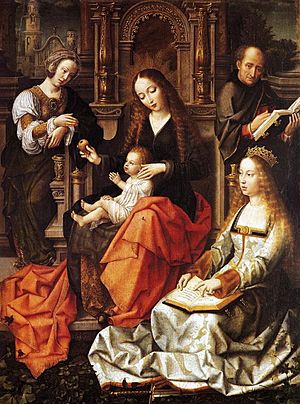
In January 1506, after Isabella's death, Ferdinand called a Cortes in Toro. Isabella's legal heirs in Castile were her daughter Joanna the Mad and Joanna's husband, Philip the Handsome. They were in the Netherlands at the time. The Cortes swore loyalty to Ferdinand as a temporary ruler. They also agreed that if Joanna was too ill to rule, Ferdinand would become regent. Ferdinand and Philip later took power from Joanna. After Philip died in September 1506, Ferdinand declared himself regent. Joanna then moved to Tordesillas.
Toro from 1500 to Today
In 1520, towns in Castile rose up against King Charles I. This was called the Comuneros Revolt. Charles had become king in 1516. Toro sided with the Comuneros. Charles defeated the Comuneros at Villalar de los Comuneros, east of Toro, the next year.
During the Peninsular War, in December 1808, British General Sir John Moore began a difficult retreat from Toro. He was facing stronger French forces. This terrible journey ended with Moore's death in A Coruña in January. In May 1813, 100,000 British troops gathered in Toro. They were under the command of Wellington. From here, Wellington launched the final campaign that drove Napoleon's armies out of Spain. This ended five terrible years of war.
An English traveler named Richard Ford (English writer) visited Toro in 1831. He reported that the town had 9,000 people. Today, it has just under 10,000. In 1838, Toro lost its status as a provincial capital. Its province was combined with Zamora.
What to See in Toro: Main Sights
The town of Toro is built in a fan shape. In the center stands the impressive Collegiate church of Santa María la Mayor. This church dates back to the 12th century. Outside, you can see the beautiful colorful western door. Inside, there is a famous painting from Flanders called La Virgen de la Mosca ("Virgin of the Fly"). There is also an unusual statue of a pregnant Virgin Mary.
Next to the collegiate church is the Espolón viewing point. From here, you can see amazing views of a fertile plain. This area is known as the "oasis of Castile."
Toro also has parts of an old wall from 910 AD. You can see the gates of Corredera and Santa Catalina, which are from the 17th and 18th centuries. Important buildings include the Law Palace, the City Hall, and the palaces of the Counts of Requena, the Marquis of Alcañices, and the Marquis of Castrillo. Among the churches, you can visit:
- San Lorenzo el Real, built in the Mudéjar style.
- San Salvador de los Caballeros, which has a Museum of Religious Art.
- San Sebastián.
- The monasteries of Sancti Spiritus, Santa Clara, and Santa Sofía.
Famous People from Toro
- Luis Cuadrado (1934–1980), a well-known cinematographer.
- Jesús López-Cobos (born 1940), a famous conductor.
- Bernardo Bonavía y Zapata (died 1812), an important political figure in New Spain (parts of North and Central America). He held roles like governor of Durango and military commander of Spanish Texas.
Toro Wine: A Rich History
Toro has been famous for its wine for a very long time. The wines from Toro were so special that King Alfonso IX of León gave them special rights in the 12th century.
When Christopher Columbus sailed to discover America in 1492, he took Toro wine with him. This was because the wine was strong and could last a long time on journeys. Friar Diego de Deza, from Zamora, helped pay for the expedition. Because of this, he was allowed to name one of the ships, the Pinta. The Pinta was half-full of Toro wine!
The official "Designation of Origin" for Toro wine is quite recent. It started in the mid-1970s. It became a full Designated Region (Denominación de Origen) on May 29, 1987.
Toro's Sister Cities
Toro has special connections with other cities around the world. These are called "twin towns" or "sister cities."
Images for kids
See also
 In Spanish: Toro (España) para niños
In Spanish: Toro (España) para niños


